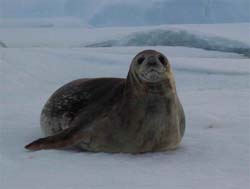

The fluctuation of mercury (Hg) concentration in seal hairs over the past 2000 years in a lake-sediment core on King George Island, West Antarctica, has been found to be closely correlated with ancient activities of gold and silver mining by using Hg-amalgamation process around the world.
The discovery was made by a polar research team led by Prof. SUN Liguang from the University of Science and Technology of China (USTC), an affiliation of CAS. Their work entitled "A 2000-year record of mercury and ancient civilizations in seal hairs from King George Island, West Antarctica" was reported at Science of the Total Environment, a key journal on environment in the world.
Thanks to elements such as keratin, animal hairs are not easy to decompose and ready to preserve adhesions. The seal hairs in the Antarctic sediments document the environmental changes in various periods. Based on their explorations to King George Island, West Antarctica, in the laboratory Sun and his students collected about 360,000 well- preserved seal hairs spanning about 2000 years in the seal excrement sediments. They determined total six metal or metalloid elements (Hg, Pb, Cu, Zn , As, Cd) in the hairs. After several years of painstaking efforts and careful analyses, they unveiled the possible linkages between the variations of Hg concentrations with the eco-environment changes.
Prof. Sun and his colleagues suggested that the hairs well shown the information of ancient world history of gold and silver mining over the past 2000 years by showing the Hg levels are high during five episodes of extensive gold and silver mining activities: Rome Empire and China Han Dynasty (about 18-300 A.D.), Maya period and China's Tang Dynasty (750-900 A.D.), Incas civilization and Christian Kingdom (1200-1500 A.D.), New World (1650-1800 A.D.), and modern industry period (1840 A.D.-present). They are low during four time periods of declined gold and silver mining activities -- the fall of China's Han Dynasty and Rome Empire (since 300 A.D.), the collapse of the Maya civilization and the Wartime Period in China (1050-1250 A.D.), Pizarro invasion (about 1532 A.D.) and Independence War of South America (1800-1830 A.D.).
"It is always wonderful to find a relationship between matters that seem irrelevant," Sun says in a recent interview with Frontiers in Ecology and the Environment, a journal of the Ecological Society of America as saying. "This work opens a door for carrying out archaeological research by way of natural sciences. It also has special meaning for research on the development of society and the cost [in terms] of environmental health," he adds.
Prof .Sun, director of the USTC Institute of Polar Environment, has been conducting archeology research into natural and social history by using "bio-elements" in the Antarctic. As early as in 2000, Sun revealed that the eco-environment variations had an impact on penguin populations in the Antarctic by using changes in the deposition of bio-elements from penguin droppings as an indirect proxy of population changes.
The findings are applauded as an example of interdisciplinary studies between natural and social sciences. It provides novel biogeochemical approach to find the lost civilizations by opening a new window on S&T archeology. It also offers basis for setting up referenced time axis in Antarctic sediments influenced by animal excrements.

86-10-68597521 (day)
86-10-68597289 (night)

86-10-68511095 (day)
86-10-68512458 (night)

cas_en@cas.cn

52 Sanlihe Rd., Xicheng District,
Beijing, China (100864)

